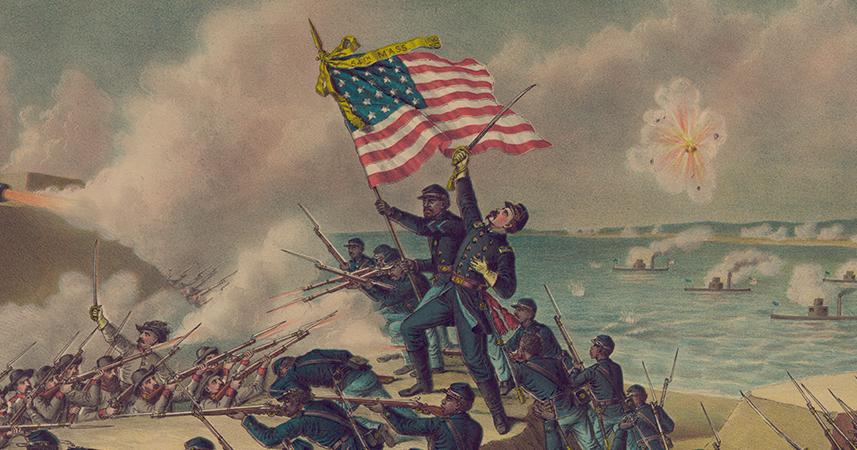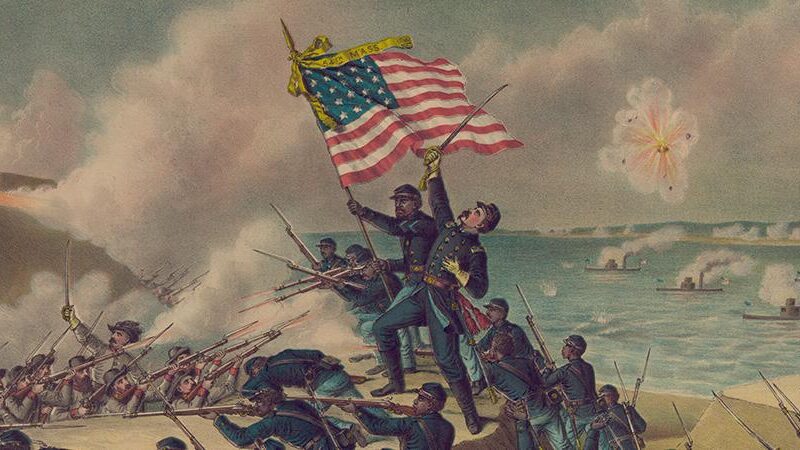The Battle of Fort Wagner happened in two installments, namely the first Battle of Fort Wagner fought on July 10, 1863, and July 11, 1863, the Second Battle of Fort Wagner fought on July 18, 1863. The Battle of Fort Wagner was a part of the Operations Against the Defenses of Charleston, which was a campaign of the Union Army. Both the battles were fought between the Federal Union army and the Confederate army during the American Civil War that spanned between 1861 and 1865.
Fort Wagner:

The American Civil war happened due to differences in the ideology of the Northern and the Southern states regarding the enslavement of people. While the Southern states still supported enslavement, the Northern states highly opposed the concept. The Battle of Fort Wagner was fought by the Union army in an attempt to acquire Fort Wagner was a beachhead type of fortification belonging to the Confederate army.
Fort Wagner was one of the best defensive beachheads of the Confederate army. It had complete control of the movement in Charleston Harbor, and the Union army wanted to restrict those Southern movements. The battle of Fort Wagner Civil war was a significant battle during the course of the American Civil War. The Battle of Wagner map includes the Charleston Harbor and the surrounding Forts of Fort Wagner, Fort Gregg, and Fort Sumter.
South Carolina was the first state to secede from the United States of America during the initial years. This was followed by the secession of other Southern states from Union. They subsequently attacked and acquired Fort Sumter, Charleston Harbor. Fort Sumter was the first acquirement of the Confederacy from the Union.
Therefore, Charleston Harbor remained as an indication of the secession for the Union. The recent acquirement of Port Royal and Fort Pulaski by General Quincy Gillmore of the Union was successful and strategically significant in Operations Against the Defenses of Charleston. Though the Battle of Fort Wagner was divided into two battles, the Second Battle of Fort Wagner was more important than the First Battle of Fort Wagner. The reason could be the active participation of the 54th Massachusetts Regiment of the Federal Union Army of the North, which included a majority of free African-American soldiers.
The First Battle of Fort Wagner:

General Gillmore was selected to take over Fort Wagner in the city of Charleston. Morris Island was home to both Fort Wagner and Fort Gregg, and General Gillmore decided to acquire both the forts. Fort Wagner was situated on the Northern end covering the whole Northern span, while Fort Gregg was located on the Southern end of Morris Island, on the outskirts of Charleston Harbor.
The Fort Wagner was equipped with an exemplary artillery system that includes a 12-pounder Howitzer, two 32-pounder Howitzers, 32-pounder Carronades, two 8-inches Shell guns, 42-pounder Carronade, an 8-inches Seacoast Howitzer, 10-inch Seacoast Mortar, 32-pounder Carronades, 10-inches Columbiad, and many more. The terrain of Fort Wagner also was an additional advantage to prevent the entry of soldiers.
The Southern end of Morris Island was protected by the primary Confederate defense. The Federal army ordered an artillery attack from warships under the command of Admiral John A. Dahlgren. This helped the forces under Brigade General George C. Strong to enter the Southern end of Morris Island. The troops under General Strong were advancing towards Fort Wagner. The heavy counterattack from the defenses of Fort Wagner was unbearable for the Federal forces. Around 339 Union men were casualties of the First Battle of Fort Wagner.
The Second Battle of Fort Wagner:

The Operations Against the Defenses of Charleston was commanded by The Second Battle of Fort Wagner happened a week later, after the initial failed attempt to acquire Fort Wagner, Charleston Harbor, South Carolina. To distract the Confederates, Brigade General Quincy Gillmore ordered an attack on Grimball’s Landing on July 16th, 1863. The Morris Island was very narrow, and, therefore, the artillery attack was quite tricky.
General Gillmore directed an attack on Fort Wagner, thus igniting the Second Battle of Fort Wagner. Along with the aid of other naval monitors, the Fort was attacked within a close range of around 300 yards from Fort Wagner. The 54th Massachusetts Volunteer Regiment was recruited by Governor John A. Andrew, who was an abolitionist. Abolitionists were people who supported the abolition of laws related to the enslavement of people during the American Civil war in the 19th century.
The recruitment was after the establishment of the Emancipation Proclamation by then-President Abraham Lincoln. The 54th Massachusetts Regiment was open recruitment with opportunities for everyone regardless of their race. Thus, the regiment was filled with a majority of black soldiers, which also further aided in the formation of a similar 55th Massachusetts Regiment.
On the 18th of July, the Second Battle of Fort Wagner was led by the famous 54th Massachusetts Volunteer Regiment under the command of Colonel Robert Gould Shaw. Only one regiment could lead since the Fort was on a narrow island called the Morris Island. The 54th Massachusetts Volunteer Regiment included various African-American men as the leading regiment
. The 54th regiment faced many problems to overcome the artillery attack and enter the fort. The Confederate army was heavily attacking the incoming Union soldiers. The Confederate army at Fort Wagner was also getting help from the nearby Fort Sumter. Fort Wagner had walls made of concrete sand and stone material, and the west side of Fort Wagner had an unpassable swamp. The 54th Regiment was backed by General George Crockett Strong and his Brigade army and General Haldiman Putnam and his Brigade.
The other Brigades attacked the seaward salient under General Strong and General Putnam. The 54th regiment forces fiercely advanced towards the fort. The 54th Regiment also reached the parapet of the fort. They even were in hand-to-hand combat with the forces, but eventually, they failed to fulfill the capture of Fort Wagner.
The other brigades and their infantry, including General Talioferrero, Colonel Putnam, put up a good fight but were unable to tolerate the continuous artillery attack of the Confederates. Most of the remaining Union men were arrested by the Confederate forces. General George Crockett Strong, Frederick Douglass’s son, Lewis Henry Douglass’s were heavily wounded in the Battle of Fort Wagner. Frederick Douglass was an African-American abolitionist. Other significant losses include the loss of Colonel Haldimand S. Putnam and the death of General Robert Gould Shaw during the Battle of Fort Wagner.

